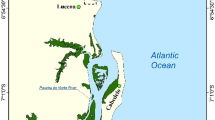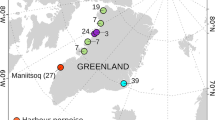Abstract
Low densities of harbour porpoises in winter (November–March) and high densities in summer (April–October) were found in the Sound, connecting the Baltic Sea and Kattegat. Due to their high energy requirements, it is hypothesized that the density of harbour porpoises is related to local prey abundance. This was tested by examining the stomach content of 53 harbour porpoises collected between 1987 and 2010 in the Sound (high season, 34 porpoises; low season, 19 porpoises). A total of 1,442 individual fish specimens from thirteen species were identified. Twelve of these were present in the high–porpoise density season and seven in the low-density season. The distribution of occurrence and the distribution of number of fish species were different between seasons, indicating a shift in prey intake between seasons. Furthermore, during the high-density season, the mean and total prey weight per stomach as well as the prey species diversity was higher. However, no difference was found in the number of prey species between the two seasons, indicating a higher quality of prey in the high-density season. Atlantic cod was found to be the main prey species in terms of weight in the high-density season while Atlantic herring and Atlantic cod were equally important during the low-density season. Prey availability and predictability are suggested as the main drivers for harbour porpoise distribution, and this could be caused by the formation of frontal zones in spring in the northern part of the Sound, leading to prey concentrations in predictable areas.





Similar content being viewed by others
References
Aarefjord H, Bjørge A, Kinze CC, Lindstedt I (1995) Diet of the harbour porpoise Phocoena phocoena in Scandinavian waters. Report Int Whal Comm Special Issue Series 16:211–222
Angantyr LA, Rasmussen J, Görranson P, Jeppesen JP, Svedang H (2007) Fisk i Øresund/Fisk i Öresund. Øresundsvandsamarbejdet
Bailey H, Thompson PM (2009) Using marine mammal habitat modelling to identify priority conservation zones within a marine protected area. Mar Ecol Prog Ser 378:279–287
Benke H, Siebert U, Lick R, Bandomir B, Weiss R (1998) The current status of harbour porpoises (Phocoena phocoena) in German waters. Arch Fish Mar Res 46:97–123
Börjesson P, Berggren P, Ganning B (2003) Diet of harbour porpoises in the Kattegat and Skagerrak Seas: accounting for individual variation and sample size. Mar Mamm Sci 19:38–58
Cappelen J, Jørgensen B (1999) Observed wind speed and direction in Denmark: with climatological standard normals, 1961–1990. Technical report 99–13. Danish meteorological Institute, Ministry of Transport, Denmark
Cardinale M, Svedang H (2004) Modelling recruitment and abundance of Atlantic cod, Gadus morhua, in the eastern Skagerrak-Kattegat (North Sea): evidence of severe depletion due to a prolonged period of high fishing pressure. Fish Res 69:263–282
Edrén SMC, Wisz MS, Teilmann J, Dietz R, Söderkvist J (2010) Modelling spatial patterns in harbour porpoise satellite telemetry data using maximum entropy. Ecography 33:698–708
Embling CB, Gillibrand PA, Gordon J, Shrimpton J, Stevick PT, Hammond PS (2010) Using habitat models to identify suitable sites for marine protected areas for harbour porpoises (Phocoena phocoena). Biol Conserv 143:267–279
Gustafsson B (1997) Interaction between Baltic Sea and North Sea. Deutsche Hydrographische Zeitschrift 49:163–181
Gustafsson B (2000) Time-dependent modeling of the Baltic entrance area. 1. Quantification of circulation and residence times in the Kattegat and the straits of the Baltic sill. Estuaries 23:231–252
Hammond PS, Berggren P, Benke H, Borchers DL, Collet A, Heide-Jorgensen MP, Heimlich S, Hiby AR, Leopold MF, Oien N (2002) Abundance of harbour porpoise and other cetaceans in the North Sea and adjacent waters. J Appl Ecol 39:361–376
Härkönen T (1986) Guide to the Otoliths of the bony fishes of the northeast Atlantic. Danbiu
Heide-Jørgensen MP, Mosbech A, Teilmann J, Benke H, Schultz W (1992) Harbor porpoise (Phocoena phocoena) densities obtained from aerial surveys North of Fyn and in the Bay of Kiel. Ophelia 35:133–146
Heide-Jørgensen MP, Teilmann J, Benke H, Wulf J (1993) Abundance and distribution of harbour porpoises, Phocoena phocoena, in selected areas of the western Baltic and the North Sea. Helgoländer Meeresuntersuchungen 47:335–346
Huse I, Ona E (1996) Tilt angle distribution and swimming speed of overwintering Norwegian spring spawning herring. ICES J Mar Sci 53:863–873
Jakobsen TS (1980) Sea water exchange of the Baltic, measurements and methods. The Belt project. The National agency of Environmental Protection, Denmark 106 pp
Jakobsen F, Castejon S (1995) Calculation of the discharge through oresund at the Drogden sill by measurements at 2 fixed stations. Nordic Hydrol 26:237–258
Kinze CC, Jensen T, Skov R (2003) Fokus på hvaler i Danmark 2000–2002. Biologiske Skrifter, nr.2, Fiskeri- og Søfartsmuseet, Esbjerg, Denmark
Koopman HN (1998) Topographical distribution of the blubber of harbor porpoises (Phocoena phocoena). J Mammal 79:260–270
Krebs CJ (1999) Ecological methodology, 2nd edn. Addison-Wesley Educational Publishers, Inc., California
Kyhn LA, Tougaard J, Teilmann J, Wahlberg M, Jorgensen PB, Bech NI (2008) Harbour porpoise (Phocoena phocoena) static acoustic monitoring: laboratory detection thresholds of T-PODs are reflected in field sensitivity. J Mar Biol Assoc UK 88:1085–1091
Lawson JW, Magalhaes AM, Miller EH (1998) Important prey species of marine vertebrate predators in the northwest Atlantic: proximate composition and energy density. Mar Ecol Prog Ser 164:13–20
Leopold M (2001) Otoliths of North Sea Fish. Fish identification key by means of otoliths and other hard parts. Expert-center for taxonomic identification
Lick RR (1991) Untersuchungen zu Lebenszyklus (Krebse-Fische-Marine Säuger) und Gefrierresistenz anisakider Nematoden in Nord- und Ostsee. Berlin Institut Meereskd, Christian-Albrechts-Universität Kiel. Kiel, Germany
Lick RR (1994) Nahrungsanalysen von Kleinwalen deutscher Küsttengewässer. University of Kiel
Lick RR (1995) Parasitologische Untersuchungen und Nahrungsanalysen von Kleinwalen deutsher Küstenwässer. University of Kiel
Lockyer C (2007) All creatures great and smaller: a study in cetacean life history energetics. J Mar Biol Assoc UK 87:1035–1045
Lockyer C, Kinze CC (2003) Status, ecology and life history of harbour porpoises (Phcoena phocoena), in Danish waters. NAMMCO Scien Public 5:143–176
Magurran E (1988) Ecological diversity and its measurement. Princeton University Press, Princeton
Marubini F, Gimona A, Evans PGH, Wright PJ, Pierce GJ (2009) Habitat preferences and interannual variability in occurrence of the harbour porpoise Phocoena phocoena off northwest Scotland. Mar Ecol Prog Ser 381:297–310
Nielsen MH (2005) The baroclinic surface currents in the Kattegat. J Mar Syst 55:97–121
Nielsen JR, Lundgren B, Jensen TF, Staehr KJ (2001) Distribution, density and abundance of the western Baltic herring (Clupea harengus) in the Sound (ICES Subdivision 23) in relation to hydrographical features. Fish Res 50:235–258
Pedersen FB (1993) Fronts in the Kattegat: the hydrodynamic regulating factor for biology. Estuaries 16:104–112
Pedersen J, Hislop JRG (2001) Seasonal variations in the energy density of fishes in the North Sea. J Fish Biol 59:380–389
Pingree RD, Pugh PR, Holligan PM, Forster GR (1975) Summer phytoplankton blooms and red tides along tidal fronts in the approaches to the English Channel. Nature 258:672–677
Santos MB, Pierce GJ (2003) The diet of harbour porpoise (Phocoena phocoena) in the northeast Atlantic. Oceanogr Mar Biol 41(41):355–390
Santos MB, Pierce GJ, Learmonth JA, Reid RJ, Ross HM, Patterson IAP, Reid DG, Beare D (2004) Variability in the diet of harbor porpoises (Phocoena phocoena) in Scottish waters 1992–2003. Mar Mamm Sci 20:1–27
SCANS-II (2008) Small cetaceans in the European Atlantic and North Sea (SCANS-II). Final report to the European Commission under project LIFE04NAT/GB/000245. University of St Andrews, St. Andrews, UK
Scheidat M, Gilles A, Siebert U (2006) Evaluating the distribution and density of harbour porpoises (Phocoena Phocoena) in selected areas in German waters. In: von Nordhein H, Boedeker D, Krause JC (eds) Progress in marine conservation in Europe: NATURA 2000 sites in German offshore waters. Springer Verlag, Berlin, pp 65–96
Siegel S (1957) Nonparametric statistics. Am Stat 11:11–19
Sih A, Christensen B (2001) Optimal diet theory: when does it work, and when and why does it fail? Anim Behav 61:379–390
Simpson EH (1949) Measurement of diversity. Nature 163:688
Skov H, Thomsen F (2008) Resolving fine-scale spatio-temporal dynamics in the harbour porpoise Phocoena phocoena. Mar Ecol Prog Ser 373:173–186
Spitz J, Mourocq E, Schoen V, Ridoux V (2010) Proximate composition and energy content of forage species from the Bay of Biscay: high- or low-quality food? ICES J Mar Sci 67:909–915
Svedang H (2010) Long-term impact of different fishing methods on the ecosystem in the Kattegat and Öresund. Report for European parliament’s committee on fisheries. IP/B/PECH/IC/2010_24. Swedish Institute for the Marine Environment
Sveegaard S (2011) Spatial and temporal distribution of harbour porpoises in relation to their prey. Ph.D. Thesis. National Environmental Research Institute, Aarhus University, Denmark
Sveegaard S, Teilmann J, Tougaard J, Dietz R, Mouritsen KN, Desportes G, Siebert U (2011a) High density areas for harbour porpoises (Phocoena phocoena) identified by satellite tracking. Mar Mamm Sci 27:230–246
Sveegaard S, Teilmann J, Berggren P, Mouritsen KN, Gillespie D, Tougaard J (2011b) Acoustic surveys confirm areas of high harbour porpoise density found by satellite tracking. ICES J Mar Sci 68:929–936
Teilmann J, Larsen F, Desportes G (2007) Time allocation and diving behaviour of harbour porpoises (Phocoena phocoena) in Danish waters. J Cetacean Res Manage 9:201–210
Verfuss UK, Honnef CG, Meding A, Dahne M, Mundry R, Benke H (2007) Geographical and seasonal variation of harbour porpoise (Phocoena phocoena) presence in the German Baltic Sea revealed by passive acoustic monitoring. J Mar Biol Assoc UK 87:165–176
Wiemann A, Andersen LW, Berggren P, Siebert U, Benke H, Teilmann J, Lockyer C, Pawliczka I, Skora K, Roos A, Lyrholm T, Paulus KB, Ketmaier V, Tiedemann R (2010) Mitochondrial control region and microsatellite analyses on harbour porpoise (Phocoena phocoena) unravel population differentiation in the Baltic Sea and adjacent waters. Conserv Genet 11:195–211
Acknowledgments
We wish to thank everyone who participated in the collection and dissection of the harbour porpoises examined in this study, especially Susi Edrén, Kristian Vedel and Tenna Rasmussen. Of the fifty-three harbour porpoises, eighteen were collected by I. Lindstedt (Natur-historiska Museum, Göteborg) and C.C. Kinze (Zoological Museum, Copenhagen) from 1987 to 1989 and stomach content was analysed by H. Aarefjord (Norwegian Institute for Nature Research, Oslo) (7 bycaught, 11 unknown, i.e. bycaught or stranded), 17 were collected and analysed by H. Andreasen (DTU Aqua) from 1989 to 2000 (14 bycaught, 3 stranded) and 18 were collected in 2009–2010 by J.P. Pedersen (The Øresund Aquarium) and analysed by H. Andreasen and S. Sveegaard (18 bycaught, 1 stranded). We are grateful to Ingalill Lindstedt and Hilde Aarefjord for giving access to the porpoise samples collected in the Sound and to the fishermen for collecting and handing over the bycaught harbour porpoises. Finally, thanks to the anonymous reviewers whose detailed comments and suggestions significantly improved this paper.
Author information
Authors and Affiliations
Corresponding author
Additional information
Communicated by U. Siebert.
Rights and permissions
About this article
Cite this article
Sveegaard, S., Andreasen, H., Mouritsen, K.N. et al. Correlation between the seasonal distribution of harbour porpoises and their prey in the Sound, Baltic Sea. Mar Biol 159, 1029–1037 (2012). https://doi.org/10.1007/s00227-012-1883-z
Received:
Accepted:
Published:
Issue Date:
DOI: https://doi.org/10.1007/s00227-012-1883-z




